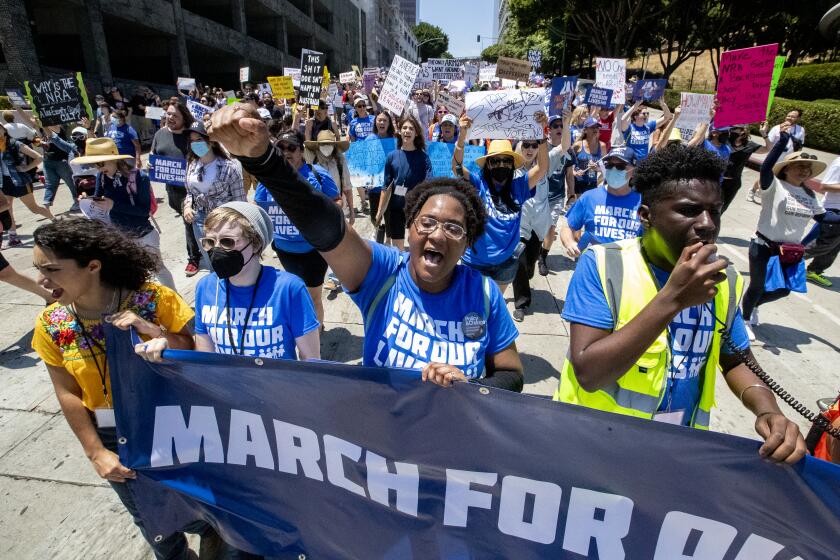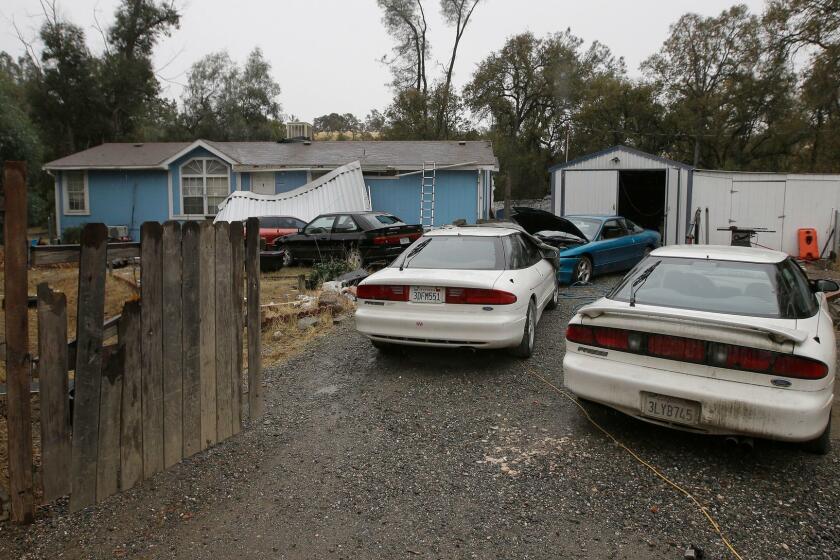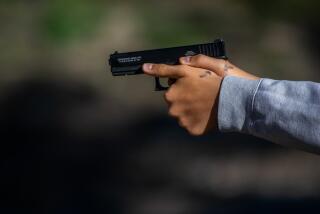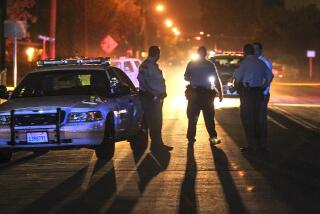
- Share via
RANCHO TEHAMA RESERVE, Calif. — Gage Elliott became an orphan on Nov. 14, 2017. He was 7 years old.
That morning, his father and paternal grandmother, who were raising him together in a modest house at the end of a gravel road, were gunned down during a mass shooting across this remote north-central California community. Over two days, according to the FBI, five people were slain and 14 others were wounded, including five children at Rancho Tehama Elementary School, before the gunman, 44-year-old Kevin Janson Neal, took his own life.
Danny Elliott and Diana Steele were killed five years after Gage’s mother died in an accident, said Sissy Feitelberg, Gage’s maternal grandmother. They were the second and third people shot to death by Neal, who lived in a light-blue mobile home barely 100 yards from their property.
Gage never spent another night in that house on Bobcat Lane where he once played in the yard with his father. He never went back to Rancho Tehama Elementary School after that day, when he and approximately 100 other students were locked down after staffers heard gunfire nearby and quickly hustled them in from recess.
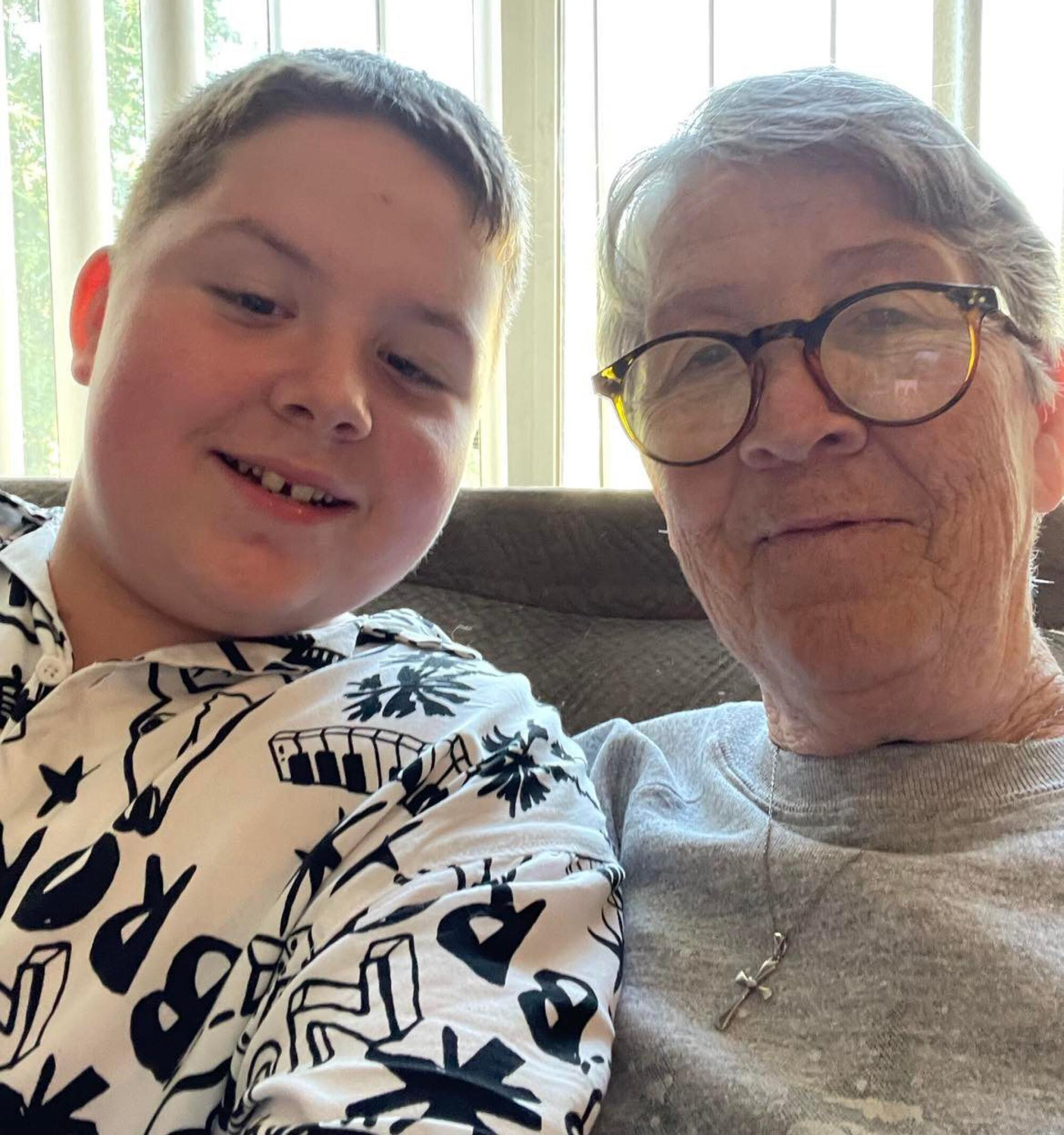
He never returned to the classroom where the gunman unsuccessfully tried to open the door, which had been locked just seconds earlier. He never saw the school’s new windows, which replaced the ones shattered by Neal’s bullets, or the repairs to the bullet holes in its cream-colored siding and turquoise-painted beams.
Gage never again saw fellow students who hid under their desks while Neal fired clip after clip at the school, including a 6-year-old who survived being shot in the chest by a bullet that traveled through a classroom wall. And he never saw the banner draped across the school’s front columns that declares “Rancho Strong” in big block letters.
“His life changed that day forever. It was gone, gone. It ripped his world,” said Feitelberg, who moved her grandson out of Rancho Tehama Reserve after the shooting. “He has not, and he will not, talk about his father. It’s definitely affected Gage, and it will for the rest of his life.”
****
Miles of rolling fields blanketed in faded wild oats and yellow starthistle line the gently curving roads into this isolated enclave an hour’s drive south of Redding.
A patchwork of country homesteads and double-wides, Rancho Tehama Reserve’s spare core features little more than a baby-blue post office with matching recreation center and homeowner’s association office, a gas station, a shuttered pizzeria and a cracked asphalt airstrip.
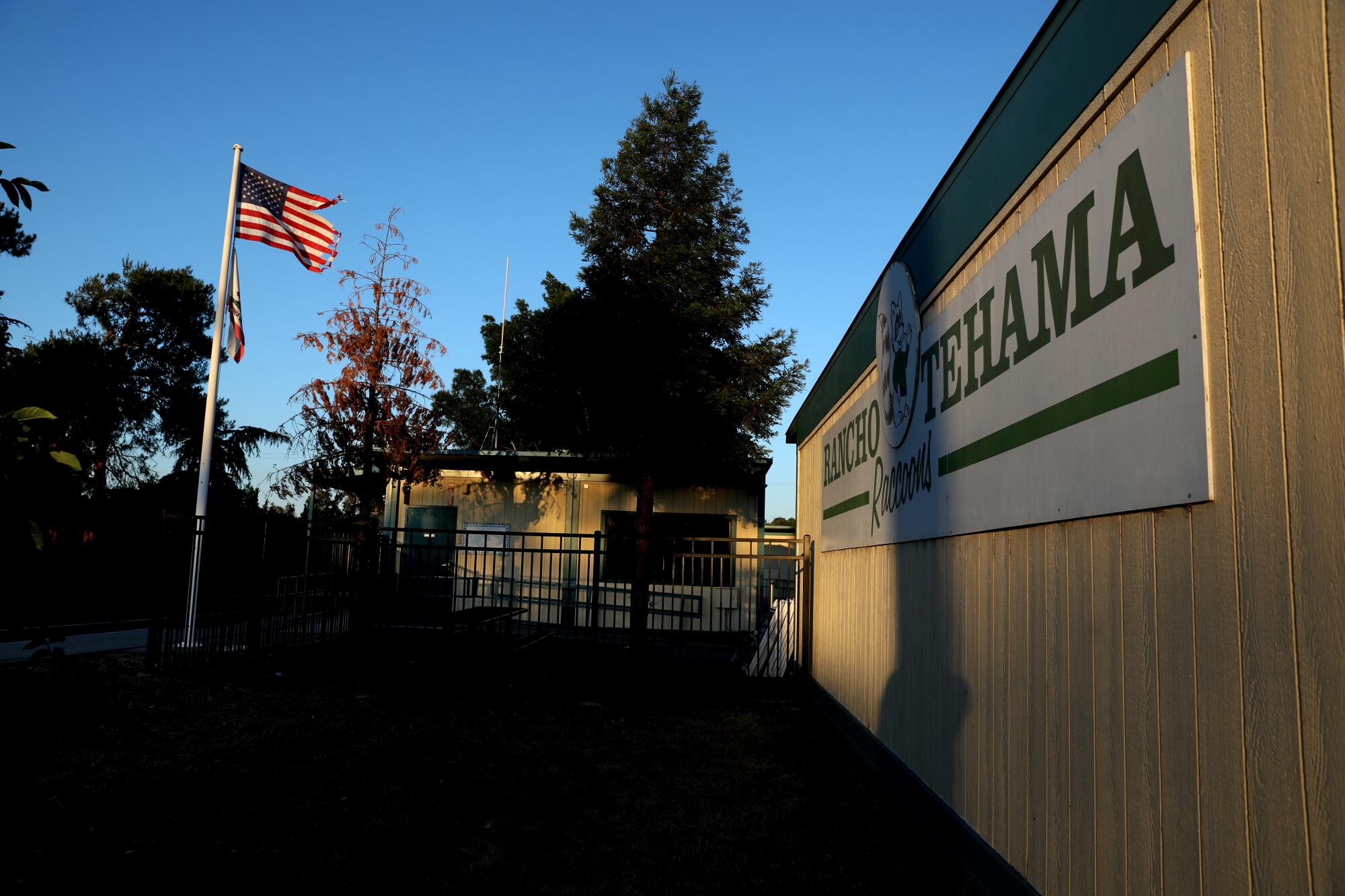
In 2017, this census-designated place with fewer than 2,000 residents made national headlines in the same way as towns like Newtown, Conn., Parkland, Fla., and Uvalde, Texas.
Four years after a gunman shot up her high school, a young journalist finds herself writing about mass shootings again. In fact, she says, she never stopped.
Neal’s shooting put Rancho Tehama Reserve — known by locals as Rancho Tehama or simply “the Ranch” — on the map, but only briefly. As with so many mass shootings across the U.S., because the death toll was comparatively low, Rancho Tehama’s was little more than another blip on the slaughter radar, forgotten by many within months.
The timing was also bad for attracting sustained news coverage and support campaigns. Barely a week earlier, a shooter killed 25 people and an unborn child and injured 22 others at a church in Sutherland Springs, Texas. That was the fifth-deadliest mass shooting in U.S. history.
And the month before, in America’s deadliest mass shooting, a gunman massacred a crowd of festival-goers in Las Vegas, killing 58 people and leaving more than 850 others injured. The shooting in Rancho Tehama simply couldn’t compete.
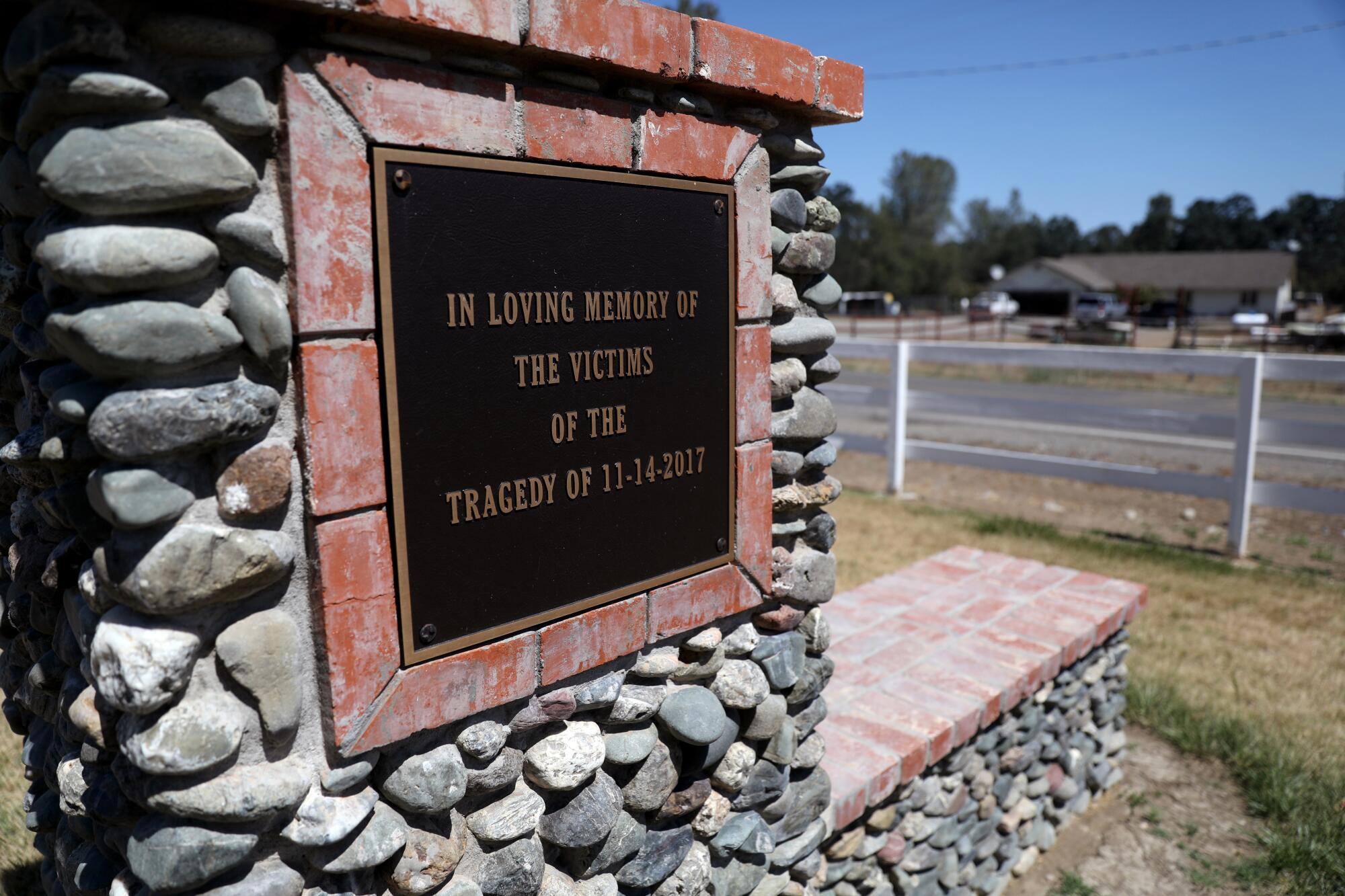
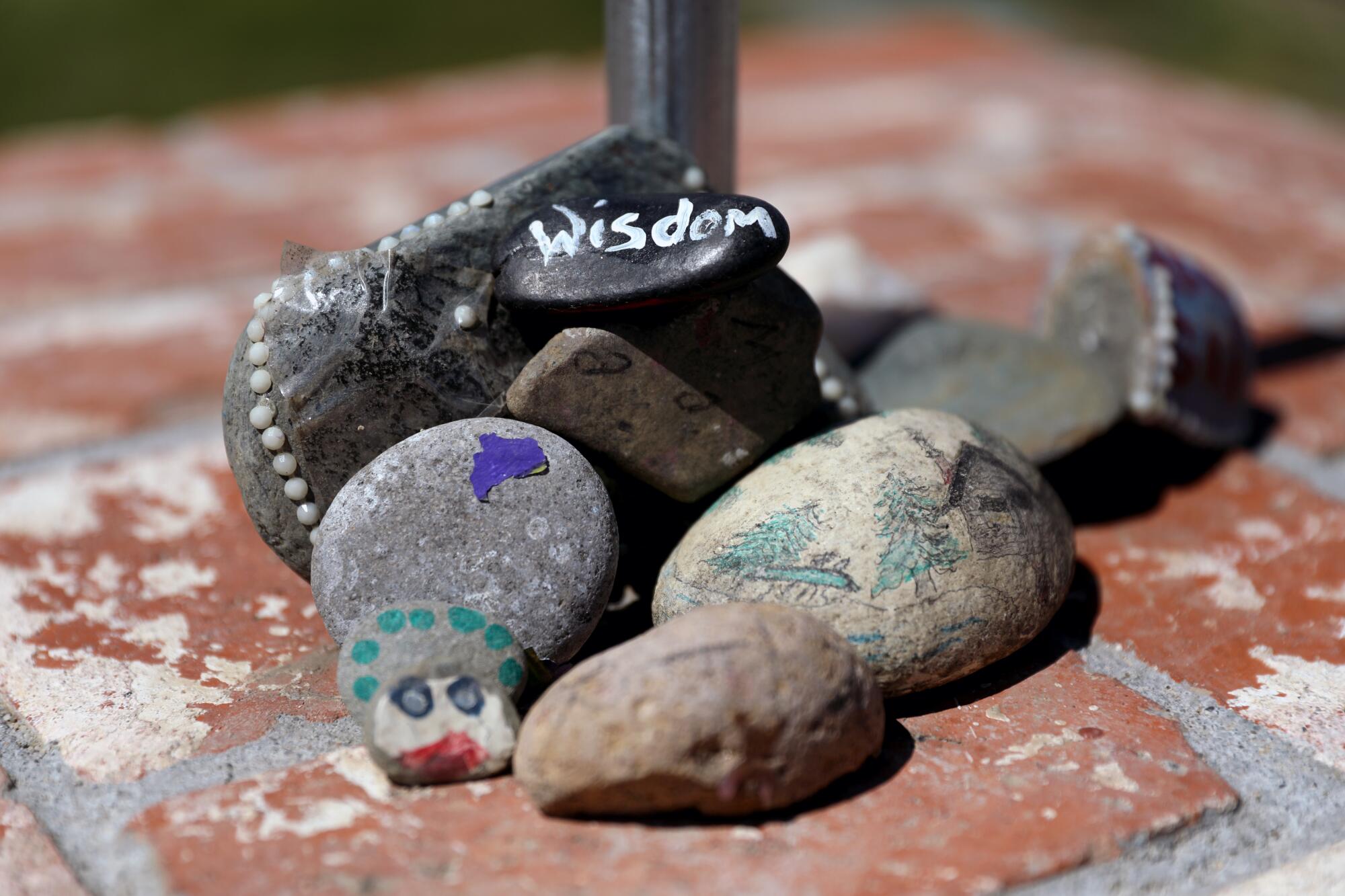
In part because of the limited media attention, people who were shot or lost loved ones that day say there has not been enough support available to help rebuild their lives.
Government programs have provided minimal long-term financial assistance, according to several people affected by the shooting who said they also were not provided sufficient access to mental health treatment. Crowdfunding efforts, which can be reliable resources for victims in the aftermath of prominent mass shootings with high death tolls, failed to raise enough money to defray the cost of their hospital bills and other needs.
That disparity echoes researchers’ findings that “the higher the body count, the more the media attention,” and the greater the outpouring of assistance, said James Densley, a sociologist and criminal justice professor at Metropolitan State University in Minnesota.
“Gun violence is so routine that there’s just not the resources there to address the problem at all,” he said. “We’re only just beginning to understand the … lack of support that families impacted by gun violence get.”
The shooter’s wife was nowhere to be found.
Time stopped in November 2017 for many who were affected by Neal’s bloody rampage, which left behind seven separate crime scenes and ended when he turned one of his guns on himself. But there’s no end in sight for the psychological misery and financial troubles left behind.
In this little-visited slice of Northern California, a mass shooting that occurred nearly five years ago has in some cases left behind battered people who have yet to reckon with its multilayered effects. Their stories are deeply personal, but they’re part of a uniquely American modern phenomenon: communities broken by mass gun violence, then largely left alone to try to pick up the pieces.
****
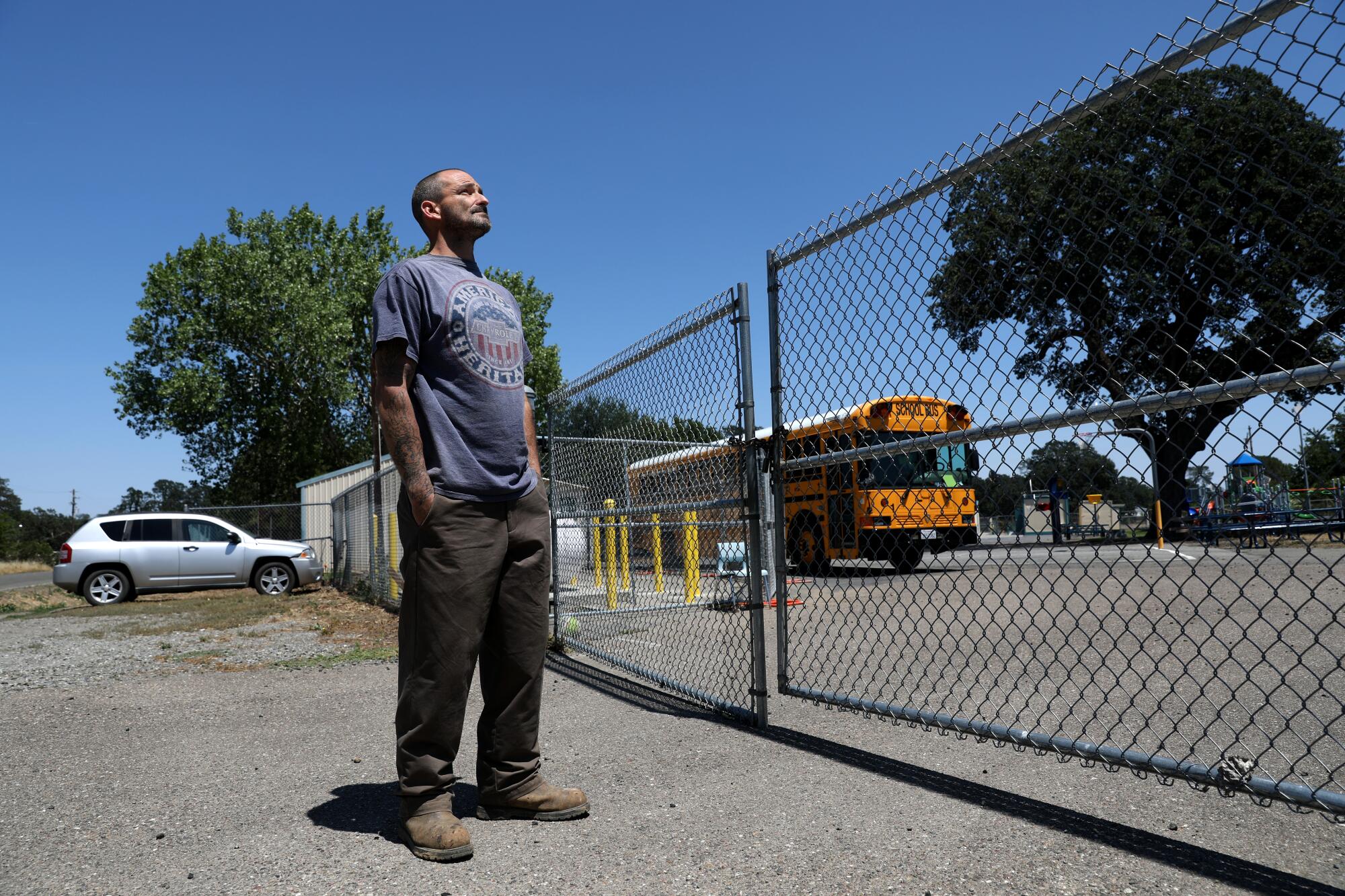
Jessie Sanders has lived in Rancho Tehama Reserve since he was 5. Muscular but skinny after a recent battle with colon cancer, the 44-year-old has a couple-inch-long pink scar where one of Neal’s bullets seared the outer flesh of his tattooed right arm.
To many in town, he’s a hero, though he says he dislikes the term. On the morning of Nov. 14, 2017, he helped prevent a potential bloodbath at the elementary school by drawing fire from the gunman in an act he brushes off as his parental duty.
Like Gage, Sanders’ son also was at Rancho Tehama Elementary when Neal arrived after shooting multiple people on his way from Bobcat Lane. After Sanders’ sister showed up at his home and told him she heard shooting near the school, he raced there, first in her car and then on foot. He ran toward the gunfire, he said, drawing Neal’s attention just as the shooter was about to step through a broken window into a classroom filled with cowering children.
Sanders yelled at Neal, calling him names and demanding the gunman shoot him instead of the children. Neal obliged, turning his assault-style rifle Sanders’ direction and firing “like 60 times,” Sanders said. Every bullet missed but the one that grazed his arm.
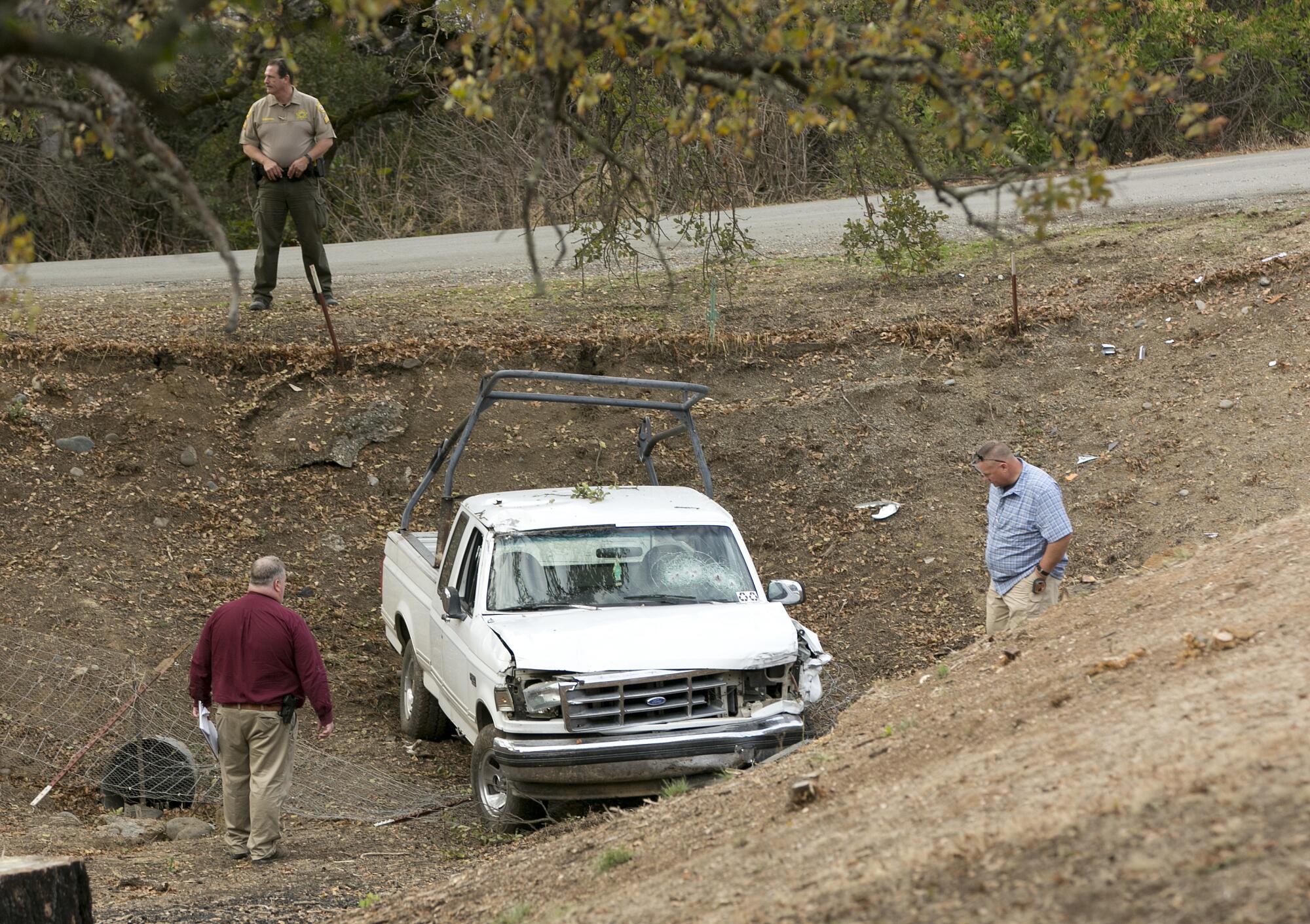
Asked about Sanders’ actions that morning, Rancho Tehama residents speak of his selflessness, bravery and kindness. But that high regard hasn’t meant much for Sanders’ everyday life.
He’s lived for several years now in a dilapidated mobile home by the airstrip. He spent most of two recent afternoons working in his yard, which has been partially subsumed by overgrown vegetation, children’s toys and assorted junk since the mass shooting.
Sanders said he knows he probably needs years of therapy and mental health treatment, but his anxiety and emotions kept him from going to see the therapists who were made available in Rancho Tehama immediately after the incident.
They’ve long since left, and Sanders said he has yet to receive any treatment for his anxiety, depression and likely PTSD.
“I don’t know how to fix it,” he said. “I’ve always understood that people have mental issues. I’ve never had them. And then, all of a sudden one day after that, I had them.”
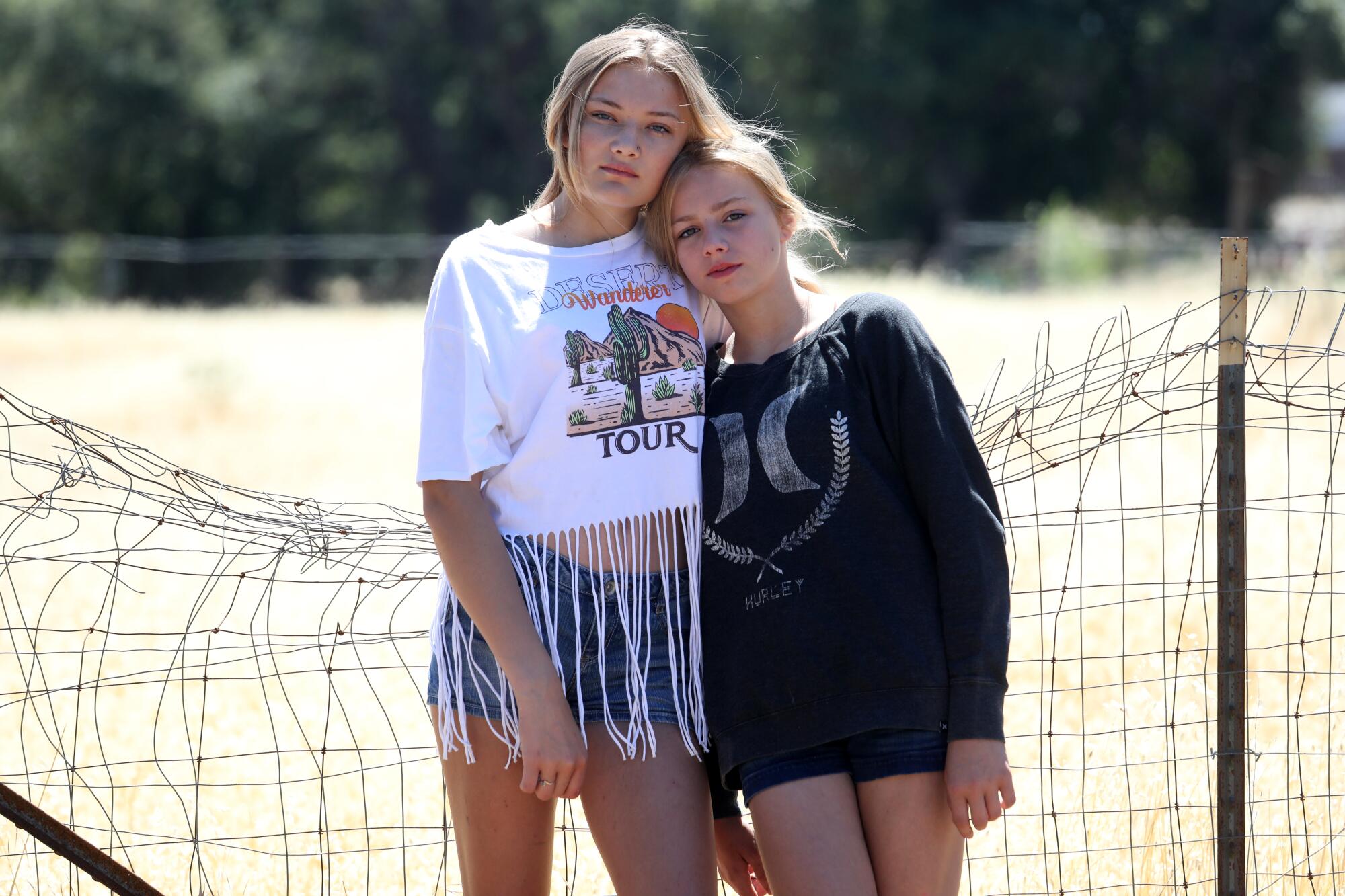
Sanders also never received any money from crowdfunding or some of the government assistance programs that could help him make ends meet.
Dan Flannery, director of the Begun Center for Violence Prevention Research and Education at Case Western Reserve University in Cleveland, said sustained assistance is key in the months and years following mass shootings.
“It’s the attention [shootings] get or don’t get that prompts the outpourings of support. I think it’s the desensitization to these events that leads to people wanting to move on,” he said. But, Flannery added, “the support that people need over time is just as important as the support needed at the time of the crisis.”
Jeff Eldred, a victim witness coordinator with the Tehama County district attorney’s office, said that the county has helped about 150 people who were affected by the violence apply for financial assistance from the California Victim Compensation Board.
“For most of them, it provided counseling, because that’s what they needed. For those who were shot, it paid for medical bills. And it paid for all the funerals other than the shooter’s,” he said. “We were helping with that for a good two years afterward.”
But little help has reached some of the hardest-hit people, like Sanders.
“I think it might have messed me up a little bit more than I thought it did, because I don’t go into public anymore … and I seem to get real short with my family when I feel like I’m getting around too many people,” he said.
“My life’s been hell since then.”
****

James Woods Jr. was driving near Rancho Tehama Elementary with his father, James Woods Sr., in the passenger seat on Nov. 14, 2017, when Neal opened fire on their car.
One bullet hit the vehicle’s metal frame near the windshield, producing a piece of shrapnel that lacerated Woods Sr.’s face near his left eye. And one of the bullets entered through Woods Jr.’s chin, tearing through the lower-right portion of his face.
The younger Woods was hospitalized for more than a week. Medical professionals cut teeth and tissue out of the then-20-year-old’s mouth. He was fed through a gastrointestinal tube. He said he’s gotten “no help at all” from the government since he was shot, but he hopes to receive state funding to help pay for dental implants.
“I have the California victim compensation through Sacramento,” he said, “so I’m kind of waiting on that. And then I have to do implants. But they still have to rip all my teeth out, and then I have to do a bone graft.”
A GoFundMe set up after the shooting to help the Woods family raised less than $6,000. Another, to help with hospital bills for a 34-year-old Rancho Tehama father who was shot in the leg, brought in less than $5,000. Even the GoFundMe to help cover medical care for the 6-year-old who was shot in the chest raised just $27,290.
Those amounts are fractions of the sums donated after more highly publicized, deadlier mass shootings. The GoFundMe drive established by family members of a teacher killed in May at Robb Elementary School in Uvalde, Texas, and her husband, who subsequently died of a heart attack, has already brought in more than $2.8 million.
A gunman’s deadly rampage through rural Rancho Tehama on Tuesday was stopped when police rammed his vehicle and exchanged shots in a fierce gun battle, authorities said.
A GoFundMe drive for an 11-year-old Robb Elementary student who was injured by bullet fragments and released from the hospital shortly after the shooting has received more than $478,000. Less than four months after the mass shooting at the Pulse nightclub in Orlando, Fla., in 2016, a Florida nonprofit announced that it alone had raised more than $9 million for victims, including $100,000 from GoFundMe itself.
Woods Jr. first filed for state victim compensation this year. Woods Sr. said his son would have applied for the funding earlier, but the trauma — including the “fire pain” of being shot and the first round of dental treatments — only recently subsided enough for Woods Jr. to take that step.
“They said we’re waiting to be approved still,” Woods Sr. said as he watched his son play with his own young children at a riverside park in Rancho Tehama one hot afternoon last month.
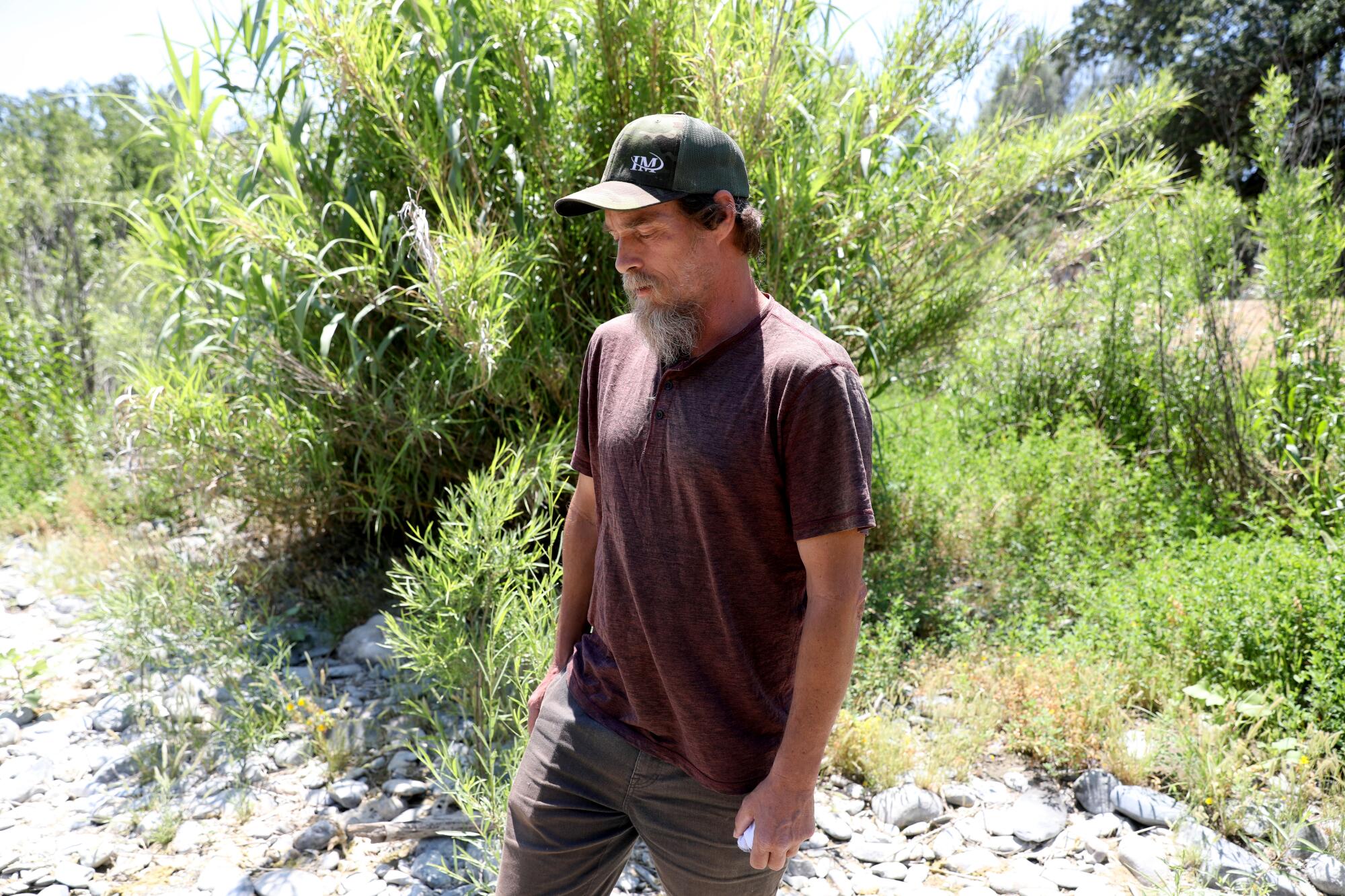
Woods Sr. doesn’t like to complain. But he said his son doesn’t feel safe living in Rancho Tehama Reserve, and neither of them has the money to leave town.
“At first it was like, well, we can give you this and that help-you-move-wise, but then you’ve got to worry about your rent and all your other big bills,” Woods Sr. said. “I feel like … if I wanted to go I can’t.”
For Woods Jr., who has extensive facial scarring, the most difficult part has been the question of how his kids will perceive him.
“Definitely the biggest thing,” he said, “is wondering how they’re going to look at their dad when they’re older.”
****
Now 12 years old, Gage moved with Feitelberg to her and her husband’s home in Sacramento immediately after the shooting. But she said “the schools in Sacramento gave Gage no support whatever.”
So Feitelberg and her grandson moved to a small town northeast of Springfield, Mass. Her husband would not go with them, so they went alone to start a new life near her son and daughter-in-law.
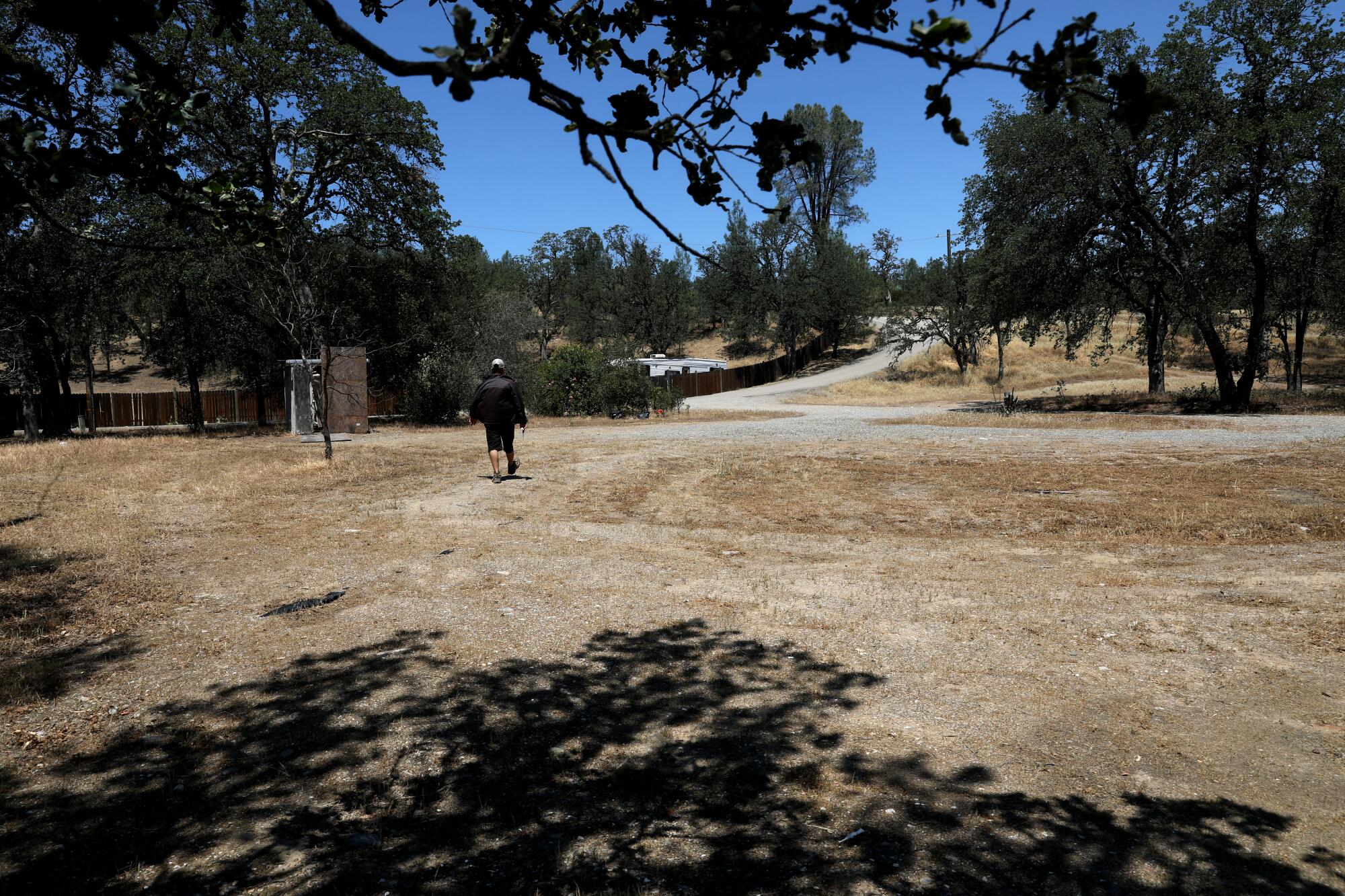
Before they split up, Feitelberg and her husband successfully applied to be Gage’s legal guardians, which enabled them to receive Social Security payments on his behalf. They also received some short-term assistance from Tehama County and about $55,000 from a GoFundMe drive.
“Other than that, we get no help from anybody. Gage gets his Social Security, I get my retirement from the state, and I get my Social Security. No one else helps us,” she said.
“I lost my marriage over it, which I don’t care, because my main thing was I wanted … to make sure Gage was safe and he felt safe.”
Gage still has a poster hanging on his bedroom wall adorned with messages from his former classmates — “we’ll miss you,” “we love you” — but about three years ago, he lost touch with the last friend from his California life. Now, nearly five years after the shooting, Feitelberg said she and Gage only truly feel secure when they’re together at home.
He gets good grades, she said, but for four years, “he kept to himself, he made no friends, he didn’t want to go out anywhere. He stays at home, he has an Oculus [virtual reality headset], and he has a computer, and he does that and that’s basically it.”
This spring, Gage started playing Little League, which he enjoys. But he still runs frightened into the house when he hears loud noises, Feitelberg said.
“All of it, all of his problems are from this incident in Tehama.”
More to Read
Sign up for Essential California
The most important California stories and recommendations in your inbox every morning.
You may occasionally receive promotional content from the Los Angeles Times.
